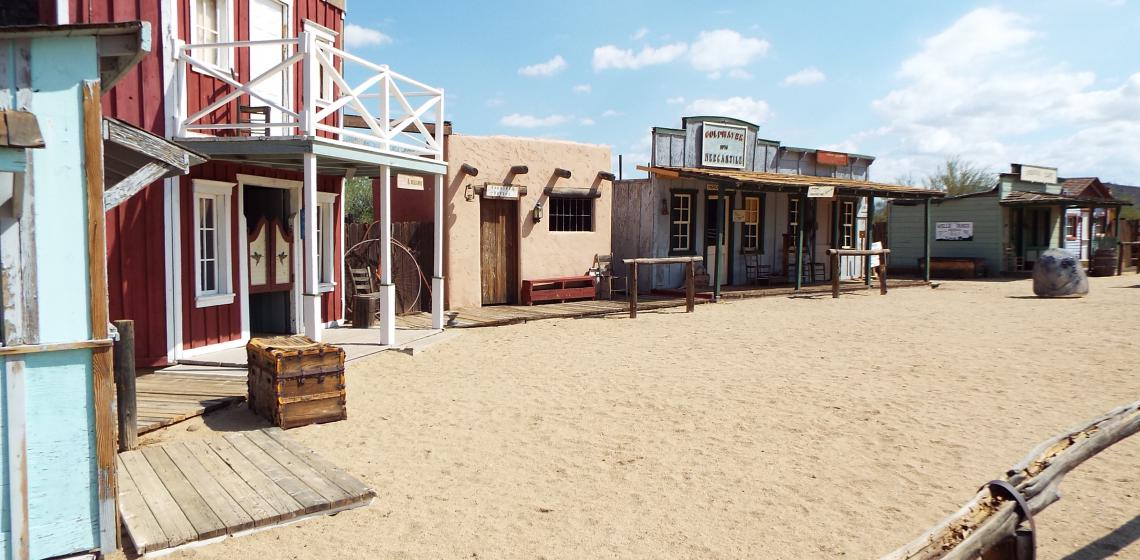
In 1956, a group of Arizona history enthusiasts became concerned about the razing and demolition of historical buildings in the state Arizona as a result of new construction by land developers. This group formed the "Pioneer Arizona Foundation, Inc. They constructed a 90 acres large reconstruction of an old 1800’s town, located on North Phoenix. The museum opened in 1969. It has ten original historical buildings and structures including the structures of a ranch complex and a farm. The museum also has 15 reconstructed buildings and/or structures.
The Bandstand is a reconstructed bandstand built in 1881 in Globe, Arizona
The Bank is a reconstructed Valley Bank built in 1884 which was located in Phoenix;
It was the first bank that was used for no other purpose than banking. The front and contents are from the original bank built in 1884, and the vault is from the Gila Valley Bank and Trust Company. The bank is reconstructed from a drawing of the original and is furnished in the style of banks of that period.
The Blacksmith Shop is a reconstruction of Middleton & Pascoe’s shop which stood in Globe, Arizona. Our blacksmith shop is based on a photograph taken during the 1870’s. The double doors at the front and back are wide enough for a team and wagon to pass through, and the floor is packed earth.
This carpenter shop is modelled after an 1880 Prescott shop. Carpenters were in demand for the construction of counters, display cases, and furniture repair as well as new buildings. The tools exhibited in the Carpenter Shop are not from the original shop but have been donated by people from all over the country.
The Community Church is the reconstruction of the St. Paul's Methodist Episcopal Church which stood in Globe, Arizona, from 1880 through 1927. The church’s painstaking and authentic reconstruction was based upon church records, original photos, newspaper clippings, personal interviews, and over 1500 hours of research. Now referred to as our Community Church, it is used for Sunday worship and is available for weddings throughout the year. The original church bell, dubbed “God’s Alarm Clock” by the residents of Globe, now graces the rebuilt St. Paul’s Methodist Church in Globe. The bell at Pioneer Arizona is a replica.
The Dress Shop is what a ready made clothing shop looked like in Phoenix in 1890
The patrons of this stop would most likely have been upper class women who could afford custom made clothing.
The Mercantile is a reconstructed 1890s store which now serves as the museums gift shop.
The Miner's Cabin is a replica of the type of cabin in the mountains of Clifton which a miner and his family would live in.
The Print Shop is a Reconstruction of an 1890 shop in Phoenix. It contains a press printer, a Washington hand press, and numerous artifacts of the period. A print shop was of paramount importance to the community in the days before radio.
This shop features operating presses typical of those used in Arizona’s Territorial newspaper and working “job” shops.
The Sheriff's Office is a reconstructed adobe building which was built in 1881 in the town of Globe. The original building was a combination of sheriff’s office, jail, and courthouse for the circuit judge who probably visited about once a month.
The Maricopa County Supervisor and Sheriff of Maricopa County built the jailhouse and obtained the original, old Maricopa jail bars and beds in 1971. The jailhouse was reconstructed from a glass plate photo of the original Gila County Courthouse.
The Southern House is a reconstructed typical "Anglo" house built in 1858 in Tucson.
This is an example of palisade and daub construction. The ends of tree trunks and branches are buried in the ground or “earthfast.” The exhibit is based on the published reminisces and illustrations of Horace Chipman Grosvenor, a wood-engraver from Ohio sent out with Phocion R. Way as agents of the Santa Rita Mining Company.
The Stage Stop is reconstructed duplicate of the Darrell Duppa Stage Station which served the old Phoenix to Wickenberg road from 1871 to 1873. It was operated by Phillip Darrell Duppa, the pioneer who credited with giving Phoenix its name
The Smith and Dodd's Tonsorial Parler is the reconstruction of a territorial barber shop
The Town Ditch is a replica of the type of ditch which was used in the towns founded by the early pioneers. The water carried by the ditches was used for drinking, cooking, washing, etc.
Fort Woods is a replica what a fort looked like in the west in the 1860s. The first structures built were replicas of those found in Fort McDowell.
The Town Cemetery is a replica of a common pioneer cemetery. The graves at the time were covered with rocks with the intention of keeping wild animals away. This particular cemetery serves as a memorial to honor some of the volunteers who helped build the museum and who are now deceased. Their names and date of death are craved on the headstones
Text source: pioneeraz.org & wikipedia
